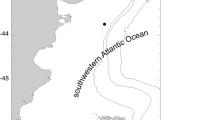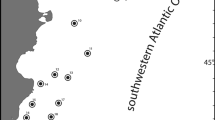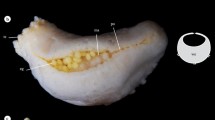Abstract
The northern sea star Leptasterias polaris (Müller and Troschel) has a unique mode of brooding its young. The mother curves her arms along the plane of the disc, the whole individual assuming a flattened plate-like shape. In this form she covers the larvae, which are attached to the substratum beneath her. The central disc is not raised to form a brood chamber, as in related species, and there is no tendency to hide while brooding. In the St. Lawrence Estuary, brooding L. polaris are common from February through May and decline in numbers during June and early July. The genus Leptasterias originates in the Arctic and probably all species brood their young.
Similar content being viewed by others
Literature Cited
Brunel, P.: Les grandes divisions du Saint-Laurent. Rev. Géogr. Montr. 24, 291–294 (1970)
Chia, F. S.: Brooding behavior of a six-rayed starfish, Leptasterias hexactis. Biol. Bull. mar. biol. Lab., Woods Hole 130, 304–315 (1966a)
Chia, F. S.: Development of a deep-sea cushion star, Pteraster tesselatus. Proc. Calif. Acad. Sci. 34 (ser. 4), 505–509 (1966b)
Djakonov, A.: Zwei neue Seesterne von dem westlichen Nordpacific. Ann. Mus. Zool. Acad. Sci. USSR 27, 310–319, pls. 21–23 (1926)
Emerson, C. J.: Larval development of the sea star, Leptasterias polaris, with particular reference to the optic cushion and ocelli. Scanning Electron Microscopy 2, 631–638 (1977)
Fisher, W. K.: Asteroidea of the North Pacific and adjacent waters. Part 1. Phanerozonia and Spinulosa. Bull. U.S. nat. Mus. 76, 1–419, 122 pls. (1911)
Fisher, W. K.: Asteroidea of the North Pacific and adjacent waters. Part 2. Forcipulata. Bull. U.S. Nat. Mus. 76, 1–245, 81 pls. (1928)
Fisher, W. K.: Asteroidea of the North Pacific and adjacent waters. Part 3. Forcipulata. Bull. U.S. Nat. Mus. 76, 1–356, 93 pls. (1930)
Fisher, W. K.: Asteroidea. Discovery Rep. 20, 69–306, 23 pls. (1940)
Grainger, E. H.: Echinoderms of Ungava Bay, Hudson Strait, Frobisher Bay and Cumberland Sound. J. Fish. Res. Bd Can. 12, 899–916 (1955)
Himmelman, J. H., Y. Lavergne and F. Axelson: L'abondance et la structure des populations d'Oursin vert, Strogylocentrotus droebachiensis, dans l'estuaire du Saint-Laurent. Québec, Min. Agr. Pêches Alimen., Dir. gen. Pêches marit., Cah. Inf. (In press)
Koehler, R.: Echinodermes. Expéd. Ant. Française (1903–5), 41 pp., 4 pls. 1906
Koren, J. and D. J. Danielssen: Observations sur le développement des astéries. Fauna Littoralis Norvegiae 2, 55–59 (1856)
Kubo, K.: Some observations on the development of Leptasterias. J. Fac. Sci. Hokkaido Univ. (ser. 6) Zool. 10, 97–105 (1951)
Lieberkind, I.: On a star-fish (Asterias grønlandica) which hatches its young in its stomach. Vid. Medd. Dansk. Nat. Hish. Foren. 72, 121–126 (1920)
Lieberkind, I.: Ctenodiscus australis Lütken. A brood-protecting asteroid. Vid. Dansk. Nat. Hist. Foren. 82, 184–196 (1926)
Ludwig, H.: Seesterne. Expéd. ant. Belge (Rés. Voy. S.Y. Belgica), Zool., 72 pp., 7 pls. 1903
Masterman, A. T.: The early development of Cribrella oculata (Forbes), with remarks on echinoderm development. Trans. R. Soc. Edin. 40, 373–418, pls. 1–4 (1902)
Menge, B. A.: Competition for food between two intertidal starfish species and its effect on body size and feeding. Ecology 53, 635–644 (1972)
Menge, B. A.: Brood or broadcast? The adaptive significance of different reproductive strategies in the two intertidal sea stars Leptasterias hexactis and Pisaster ochraceus. Mar. Biol. 31, 87–100 (1975)
Mortensen, T.: The Godthaab Expedition 1928. Echinoderms. Medd. om Grønland 79, 62 pp. (1932)
O'Brien, F. X.: Some adaptations of the seastar, Leptasterias littoralis (Stimpson) to life in the intertidal zone. Thal. Jugosl. 12, 237–243 (1976)
Osterud, J.: Development of Leptasterias hexactis. Publ. Puget Sound mar. biol. Sta. 2, 1–15 (1918)
Perrier, E.: Echinodermes de la mission scientifique du Cap Horn. 1. Stellérides. Miss. sci. Cap Horn, Zool. 4, 198 pp., 13 pls. (1891)
Philippe, R. A.: Neue Seesterne aus Chile. Arch. Naturges. 36, 286–275, pl. 3 (1870)
Sars, M.: Beobachtungen über die Entwicklung der Seesterne. Fauna Littoralis Norvegiae 1, 47–62 (1846)
Smith, E. A.: Description of species of Asteriidae and Linckiidae in the British Museum. Ann. Mag. nat. hist. (ser. 4) 17, 106–107 (1876)
Smith, E. A.: Echinodermata. Zoology of Kerguelen Island. Phil. Trans. R. Soc. Lond. 167, 270–281, pls. 16–17 (1879)
Smith, R. H.: Reproductive biology of a brooding sea-star, Leptasterias pusilla (Fisher), in the Monterey region, 225 pp. Ph. D. thesis. Stanford University 1971
Steenstrup, J.: Om de ved Grönlands forekommende Asteracanthion-Arter. Forhandlingen ved de skandinaviske Naturforskers. F. Möde, Christiania (1856), 228–232 (1857)
Studer, T.: Die Seesterne Süd-Georgiens nach der Ausbeute der deutschen Polarstation, 1882 und 1883. Jahrb. wiss. Anstal. Hamburg 2, 141–166, pls. 1–2 (1885)
Thomson, W.: Notice of peculiarities in the mode of propagation of certain echinoderms of the southern sea. J. Linn. Soc. London, Zool. 13, 55–79 (1878)
Thorson, G.: Reproduction and larval development of Danish marine bottom invertebrates. Medd. Kommn. Danm. Fisk.—og Havunders., ser. Plankton 4, 1–523 (1946)
Thorson, G.: Reproduction and larval ecology of marine bottom invertebrates. Biol. Rev. 25, 1–45 (1950)
Verrill, A. E.: Monograph of the shallow-water starfishes of the North Pacific Coast from the Arctic Ocean to California. Smithsonian Inst., Harriman Alaska Ser. 14, 408 pp. (1914)
Worley, E. K., D. R. Franz and G. H. Hendler: Seasonal patterns of gametogenesis in North Atlantic brooding asteroid, Leptasterias tenera. Biol. Bull. mar. biol. Lab., Woods Hole 153, 237–253 (1977)
Author information
Authors and Affiliations
Additional information
Communicated by R. O. Fournier, Halifax
This paper is dedicated to François Dorion who lost his life during benthic studies in the St. Lawrence Estuary. His enthusiasm in studying marine organisms will always be an inspiration to us
Contribution to the program of GIROQ (Groupe Interuniversitaire de Recherches Océanographiques du Québec)
Rights and permissions
About this article
Cite this article
Himmelman, J.H., Lavergne, Y., Cardinal, A. et al. Brooding behaviour of the northern sea star Leptasterias polaris . Mar. Biol. 68, 235–240 (1982). https://doi.org/10.1007/BF00409590
Accepted:
Issue Date:
DOI: https://doi.org/10.1007/BF00409590




